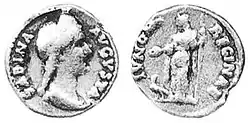| Vibia Sabina | |||||||||
|---|---|---|---|---|---|---|---|---|---|
| Augusta | |||||||||
_01.jpg.webp) Statue of Vibia Sabina (Villa Adriana, Tivoli) | |||||||||
| Roman empress | |||||||||
| Tenure | 117 – 136/137 | ||||||||
| Born | 83 Rome, Italy | ||||||||
| Died | 136/137 | ||||||||
| Spouse | Hadrian | ||||||||
| |||||||||
| Dynasty | Nerva–Antonine | ||||||||
| Father | Lucius Vibius Sabinus | ||||||||
| Mother | Salonia Matidia | ||||||||

Vibia Sabina (83–136/137) was a Roman Empress, wife and second cousin once removed to the Roman Emperor Hadrian. She was the daughter of Matidia (niece of Roman Emperor Trajan) and suffect consul Lucius Vibius Sabinus.
Early life
After her father's death in 84, Sabina and her half-sister Matidia Minor went to live with their maternal grandmother, Marciana. They were raised in the household of Sabina's great uncle Trajan and his wife Plotina.
Sabina married Hadrian in 100, at the empress Plotina's request. Sabina's mother Matidia (Hadrian's second cousin) was also fond of Hadrian and allowed him to marry her daughter. Hadrian succeeded Trajan in 117.
Empress
Sabina accumulated more public honors in Rome and the provinces than any imperial woman had enjoyed since the first empress, Augustus’ wife Livia. Indeed, Sabina is the first woman whose image features on a regular and continuous series of coins minted at Rome. She was the most traveled and visible empress to date.[1] In 128, she was awarded the title of Augusta.
Sabina is described in the poetry of Julia Balbilla, her companion, in a series of epigrams on the occasion of Hadrian's visit to Egypt in November of 130. In the poems, Balbilla refers to Sabina as "beautiful" and "lovely."
The Historia Augusta reports that the historian Suetonius, who was Hadrian's secretary, was dismissed by Hadrian from his position in 119, for "conducting [himself] toward his wife, Sabina, in a more informal fashion than the etiquette of the court demanded."[2][3] Meanwhile, her husband was thought to be more sexually interested in his favourite Antinous and other male lovers, and he and Sabina had no children.
Death

Vibia Sabina died before her husband, some time in 136 or early 137.[4] There is a strong ancient tradition that Hadrian treated his wife little better than a slave, and may have driven her to suicide.[1] However other sources say he had great respect for her.
A relief commissioned by Hadrian "depicts the apotheosis, or divine ascent of Sabina in accordance with her posthumous deification on the order of Hadrian."[5] Some 150 years later, this was reused as spolia on the so-called Arch of Portugal, and in modern times moved to the Capitoline Museums, where it is on display on the staircase of the Palazzo dei Conservatori.
Temple
According to researchers, a temple at Elefsina in Greece was dedicated to Sabina.[6]
See also
- Vibia Aurelia Sabina (170-died before 217), great-greatniece to Vibia Sabina
Nerva–Antonine family tree
| |
| Notes:
Except where otherwise noted, the notes below indicate that an individual's parentage is as shown in the above family tree.
| |
References:
|
References
- 1 2 Brennan, Corey (2018). Sabina Augusta. Oxford University Press. ISBN 978-0190250997.
- ↑ Historia Augusta 11.3
- ↑ Chisholm, Hugh, ed. (1911). . Encyclopædia Britannica. Vol. 26 (11th ed.). Cambridge University Press.
- ↑ Opper, Thorsten. Hadrian: Empire and Conflict, Harvard University Press, 2008, p. 205. ISBN 0-674-03095-8
- ↑ Annelise Freisenbruch, Caesars’ Wives: Sex, Power, and Politics in the Roman Empire (London and New York: Free Press, 2010), 170.
- ↑ Archaeological Site of Eleusis-Temple of Sabina
Further reading
- (in French) L’Harmattan, La vie de Sabine, femme d’Hadrien, in Minaud, Gérard, Les vies de 12 femmes d’empereur romain – Devoirs, Intrigues & Voluptés , Paris, 2012, pp. 169–188.
- Brennan, Corey T., Sabina Augusta: An Imperial Journey, Oxford, 2018, ISBN 978-0190250997